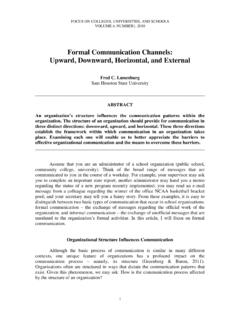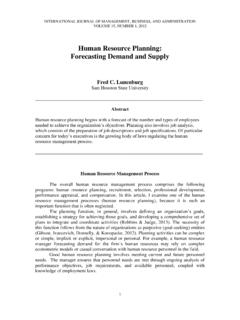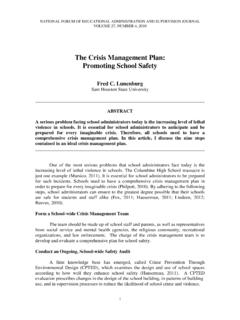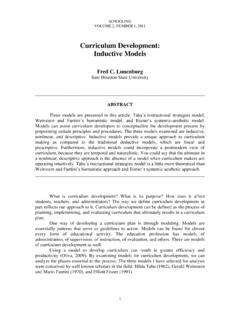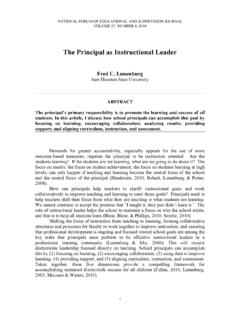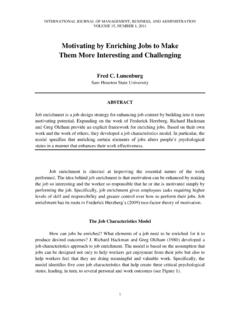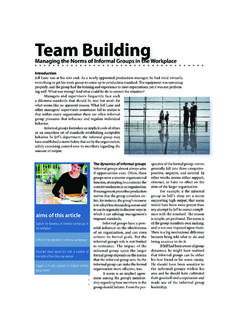Transcription of Network Patterns and Analysis: Underused …
1 NATIONAL FORUM OF EDUCATIONAL ADMINISTRATION AND SUPERVISION JOURNAL VOLUME 28, NUMBER 4, 2011 1 Network Patterns and analysis : Underused Sources to Improve communication Effectiveness Fred C. Lunenburg Sam Houston State University _____ ABSTRACT Communications flow in four directions downward, upward, horizontally, and diagonally. Organizational communication also flows through a formal Network . The five most common networks are the chain, Y, wheel, circle, and all-channel. Besides Network Patterns , another method to help school administrators analyze communication flows and Patterns is Network analysis .
2 In Network analysis , communication flows and Patterns are analyzed between units and across hierarchical positions. Network analysis uses survey sociometry to identify cliques and certain specialized roles of the members in the communication structure of real-life organizations. Also existing in organizations is an informal communication Network the grapevine that can serve as another important source of information to school administrators. _____ communication Networks Organizational communication can be transmitted in a number of directions: downward, upward, horizontally, diagonally, and through the grapevine.
3 These communications can be formal or informal; in either case, the actual pattern and flow of communication connecting senders and receivers are called communication networks. Because this system contains all the communication of the organization, these networks have a pervasive influence on the behavior of individuals functioning within them. Network Patterns Network Patterns are derived from laboratory experiments in which the structure of the groupings can be manipulated by the experimenter (Hollingshead, 2012).
4 Figure 1 depicts five of the more frequently used networks (wheel, chain, Y, circle, and all-channel). The major difference among the networks is the degree to which they are centralized or decentralized (Ramos, 2012). Each Network pattern is discussed in turn. NATIONAL FORUM OF EDUCATIONAL ADMINISTRATION AND SUPERVISION JOURNAL 2_____ . Chain Y Wheel Circle All-Channel Figure 1. Common communication networks.
5 The wheel Network , a two-level hierarchy, is the most structured and centralized of the Patterns because each member can communicate with only one other person. For example, a superintendent of schools and those who are his immediate subordinates (assistant superintendent for business, instruction, personnel, and assistant to the superintendent), probably form a wheel Network . The superintendent is A, and his assistant superintendents are B, C, D, and E, respectively.
6 The four subordinates send information to the superintendent, and the superintendent sends that information back to them, usually in the form of decisions. The chain Network ranks next highest in centralization. Only two people communicate with one another, and they in turn have only one person to whom they communicate. Information is generally sent through such a Network in relay fashion. A typical chain Network would be one in which a teacher (B) reports to the department head (C), who in turn reports to the principal (A), who reports to the superintendent (D).
7 Another example is the grapevine through which information passes throughout a school building or district between different departments and organizational levels. The Y Network is similar to the chain except that two members fall outside the chain. In the Y Network , for example, members A and B can send information to C, but they can receive information from no one. C and D can exchange information; E can receive information from D but cannot send any information. For example, two assistant principals, (A and B) report to the principal (C).
8 The principal, in turn, reports to the assistant superintendent (D), who reports to the superintendent (E). The circle Network , a three-level hierarchy, is very different from the wheel, chain, and Y networks. It is symbolic of horizontal and decentralized communication . The circle gives every member equal communication opportunities. Each member can communicate with persons to their right and left. Members have identical restrictions, but the circle is a less restricted condition than the wheel, chain, or Y networks.
9 For example, the circle Network has more two-way channels open for problem solving ( , five) than the four channels of the aforementioned networks. In the circle Network , everyone becomes a decision maker. The all-channel Network is an extension of the circle Network . By connecting everyone in the circle Network , the result is a star, or all-channel Network . The star Network permits each member to communicate freely with all other persons(decentralized B B B B B C A A A A A C C C C D D D D D E E E E FRED C.)
10 LUNENBURG _____3 communication ). The star Network has no central position, and no communication restrictions are placed on any member. A committee in which no member either formally or informally assumes a leadership position is a good example of a star Network . Effectiveness of different networks. The importance of a communication Network lies in its potential effects on such variables as speed, accuracy, morale, leadership, stability, organization, and flexibility. Studies in communication networks show that the Network effectiveness depends on situational factors (Kim, 2012).
